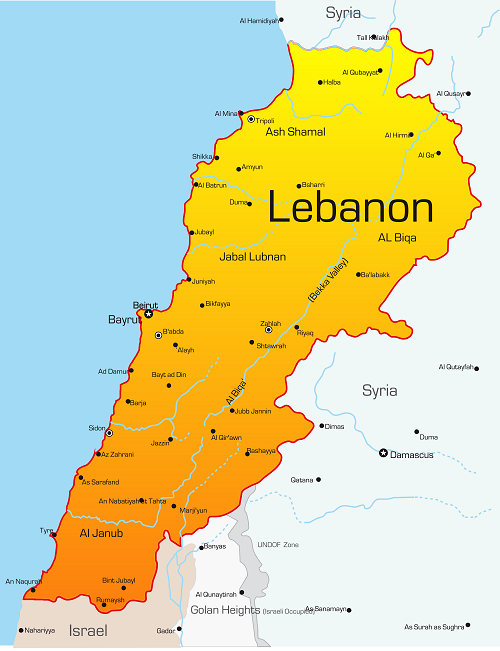- Lebanon’s geographical diversity creates a unique climate characterized by three distinct zones. Your experience in this small yet diverse country can vary significantly depending on where you choose to visit. But don’t worry; with approximately 300 days of sunshine annually, Lebanon offers ample opportunities to savor favorable weather.
Spring in Lebanon
Spring, spanning from early April through mid-June, is undoubtedly the best time to visit Lebanon. During this period, the weather conditions are enchantingly radiant and warm, with temperatures going somewhere in the range of 15 and 28 degrees Celsius. Whether you’re exploring the vibrant capital city of Beirut, coastal towns, or historic sites like the ruins of Baalbek, spring in Lebanon promises a delightful travel experience.
Autumn: Another Window of Opportunity
As the year progresses, Lebanon’s autumn, from September to November, extends another wonderful time to explore this nation. Beirut enjoys pleasant temperatures ranging between 16 and 30 degrees. It’s an best time to visit Lebanon to bask in Lebanon’s beaches and engage in mountain hiking, all while admiring the changing foliage.
Summer in Lebanon: Fun in the Sun
Summer, from June to September, brings sunshine, beach parties, and an array of cultural events. The coastal cities and the Bekaa Valley offer a perfect blend of warmth and outdoor activities, making it a splendid time for swimming, beach parties, and exploration. Be that as it may, be ready for high temperatures, particularly in Beirut, where it can arrive at 30 degrees Celsius, and don’t anticipate precipitation during this time.
Lebanon’s Winter Charms
Lebanon’s winters, from December to March, are relatively mild in the plains. This is the season for skiing and snowboarding, especially in the country’s ski resorts like Zaarour and Mzaar. While Beirut experiences temperatures ranging from 11 to 19 degrees, the mountains are transformed into winter wonderlands, attracting those eager to hit the slopes and admire the snowy landscapes.
Monthly Breakdown in Lebanon
To assist you with arranging your visit to Lebanon all the more really, here’s a month-to-month breakdown that features the weather patterns and exercises you can appreciate consistently.
January: Enjoy a Mild Winter
In January, Lebanon experiences a mild winter with temperatures averaging around 11 to 19 degrees Celsius. While snowfall is rare in Beirut, the mountains may see some. It’s a great time to explore historical sites and enjoy the local culture; just remember to bring some warm clothing for the cooler nights.
February: Cultural Exploration and Pleasant Weather
February offers a pleasant escape from the harsh winter. It’s an extraordinary chance to drench yourself in Lebanon’s rich social legacy. Visit cities like Beirut, Tripoli, or Byblos to explore historical sites and ancient ruins. The temperatures remain similar to January, with the possibility of occasional rainfall.
March: Welcoming Spring
As March arrives, Lebanon starts to welcome the spring season. This is a fantastic time to embark on a journey of discovery. The weather becomes more agreeable, with temperatures rising slowly. Assuming you appreciate investigating nature, this is a magnificent chance to go to the open country, with olive forests and grape plantations in full blossom.
April: Blooming Beauty
April is when Lebanon truly comes alive with nature’s beauty. Temperatures start to rise, venturing into the 20s, and the remainder of the showers clears up. By late April, expect wall-to-wall sunshine, making it ideal for outdoor activities, cultural exploration, and soaking up the sun at the country’s beaches.
May: Wall-to-Wall Sunshine
May marks the beginning of summer in Lebanon. With temperatures averaging around 26 degrees Celsius, it’s an ideal chance to partake in the bright sea shores and outside exercises. On the off chance that you love watersports, this is a magnificent opportunity to take a stab at windsurfing, waterskiing, or cruising.
June: Embrace the Summer
June continues the summery feel in Lebanon, with temperatures regularly averaging 30 degrees Celsius. You can look forward to a sun-soaked vacation, beach parties, and cultural events. Lebanon’s vibrant nightlife and clear skies make June a best time to visit Lebanon.
July and August: Peak of Summer
July and August are the peak of summer, with temperatures in Beirut averaging between 24 and 30 degrees Celsius. The coast and places like the Bekaa Valley get exceptionally hot and dry during this time. It’s ideal for beachgoers but be prepared for humidity. Escape to the mountains, like the Qadisha Valley, for a respite from the coastal heat.
September: Transitional Month
In September, Lebanon experiences a transition from summer to autumn. Beirut’s temperatures range between 16 and 30 degrees, making it a pleasant time for beach activities and outdoor adventures. It’s also an excellent month for hiking.
October: Delightful Autumn
October continues the pleasant autumn weather, with temperatures around 30 degrees in Beirut. The mountains provide a pleasant escape from the city’s heat, making it a haven for nature enthusiasts who enjoy hiking trails.
November: Mild and Comfortable
November offers mild temperatures and is an excellent time to explore Lebanon. The coastal areas remain in the teens, providing a comfortable atmosphere. It’s a great month for cultural and historical exploration.
December: Embrace Winter Activities
December heralds the winter season in Lebanon. Beirut experiences mild temperatures, making it a favorable time to explore the city. The mountains become snowy wonderlands, attracting skiers and snowboarders. If you’re looking for a unique experience, Lebanon’s ski resorts are in full swing from December until May.

